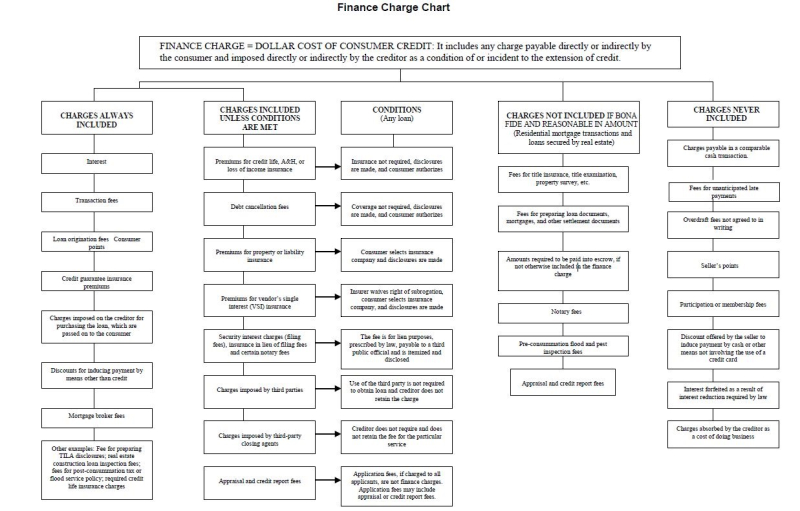Consumer Compliance Outlook-Understanding Finance Charges for Closed-End Credit; Implementing the Consumer Compliance Rating System
Consumer Compliance Outlook. The first 2017 issue of the Philadelphia Federal Reserve's Consumer Compliance Outlook is now available. This issue's articles include:
- Combating Elder Financial Abuse (for more information, see this past blog post)
- On the Docket: Recent Federal Court Opinions
- Understanding Finance Charges for Closed-End Credit
- Implementing the New Uniform Interagency Consumer Compliance Rating System
Today's blog post will highlight some key concepts from the articles "Understanding Finance Charges for Closed-End Credit" and "Implementing the New Uniform Interagency Consumer Compliance Rating System".
"Understanding Finance Charges for Closed-End Credit"
Regulation Z defines "finance charge" as "the cost of consumer credit as a dollar amount. It includes any charge payable directly or indirectly by the consumer and imposed directly or indirectly by the creditor as an incident to or a condition of the extension of credit. It does not include any charge of a type payable in a comparable cash transaction." While on its face, the definition of finance charge seems clear, it becomes challenging to apply because of the wide range of fees and charges that can be incurred in credit and because the definition is subject to several exceptions. Although the definition of a finance charge is the same for closed- and open-end credit transactions, the disclosure rules are different. The Consumer Compliance Outlook article provides a detailed discussion on the disclosure of finance charges for closed-end credit transactions.
The article also includes a table (see, p. 6) which displays the "Interagency Examination Procedures for Regulation Z," which credit unions may find helpful for identifying finance charges. The article notes that this chart is meant only as a guide. The chart separates charges into several categories: 1) some charges that are always included in the finance charge, 2) some that are always excluded, 3) some that may be excluded if certain conditions are met, and 4) some that are excluded with respect to credit secured by real property or in a residential mortgage transaction (even though they would be considered finance charge in other types of credit transactions).
The article also discusses the importance of identifying and disclosing the finance charge. The finance charge can contribute to errors in other TILA disclosures that rely upon an accurate finance charge. For instance, the APR is calculated based on the finance charge. Note, Regulation Z defines tolerances with respect to the disclosed finance charge. For closed-end loans, the tolerances appear in Section 1026.18(d). An inaccurate disclosure of the finance charge and an APR outside of tolerances can result in restitution to consumers affected by an error.
Since properly classifying fees as finance charges can be challenging, and errors can be costly, the article also discusses common issues Federal Reserve examiners have seen that result in finance charge errors. Subsequently, the article provides credit unions with tips and tools to prevent finance charge violations, such as enhancing controls to mitigate potential risk. The article also suggests appropriately training staff and reviewing disclosure systems will also help to prevent disclosure errors.
"Implementing the New Uniform Interagency Consumer Compliance Rating System".
In November 2016, the Federal Financial Instructions Examination Council (FFIEC) announced its updated Uniform Interagency Consumer Compliance Rating System (CC Rating System). The revisions reflect the regulatory, examination, technological and market changes that have occurred since the release of the original rating system.
According to the article, the CC Rating System is a supervised policy used by the agencies' examiners to evaluate financial institutions' adherence to consumer compliance laws and regulations. The primary purpose of the CC rating system is to ensure that financial institutions are elevated in a comprehensive and consistent manner and that supervisory resources are appropriately focused on areas exhibiting the risk of consumer harm and on institutions that warrant elevated supervisory attention.
The FFIEC developed the following principles to serve as a foundation for the CC Rating System: Risk-Based; Transparent; Actionable; Incentives for Compliance. Note, the revised CC Rating System was not developed to set new or higher supervisory expectations for financial institutions. Instead, the revised system provides a consumer compliance rating that more fully complements the agencies' risk-focused examination.
The CC Rating System establishes a framework of compliance factors that examiners use during consumer compliance examinations to assess a financial institution's performance. The 12 CC Rating System assessment factors are organized within the following three categories: Board and Management Oversight; Compliance Program; Violations of Law and Consumer Harm. Based upon the examiners' comprehensive evaluation of the institution's performance under those assessment factors, the examiners assign an overall consumer compliance rating to the financial institution.
Credit unions can anticipate discussing the new CC Rating System during their next consumer compliance examination.

